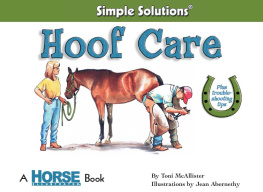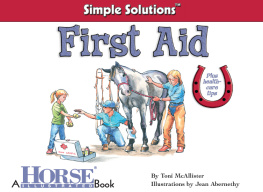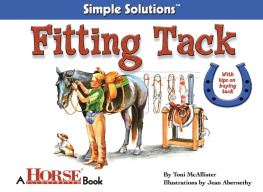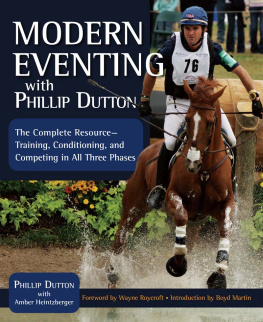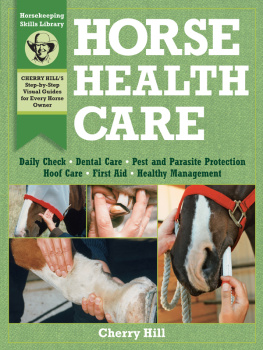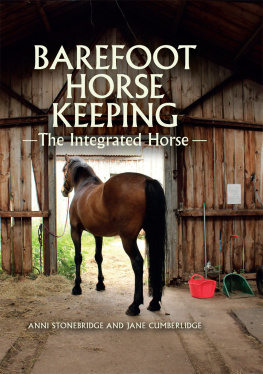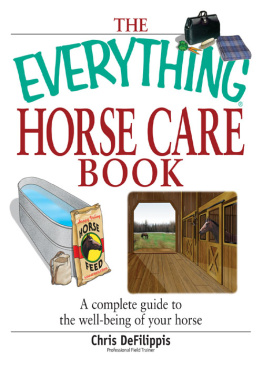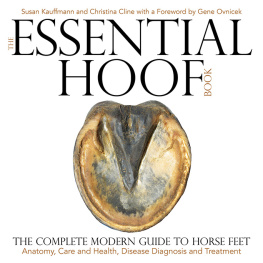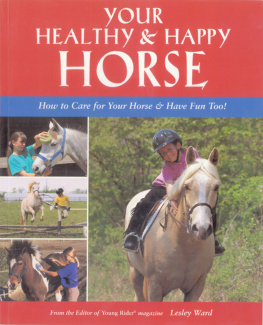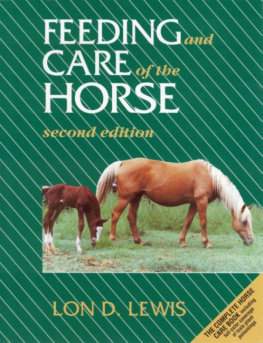The horses in this book are referred to as she and he in alternating chapters unless their sexes are apparent from the activities discussed.
Copyright 2008, 2009 by I-5 Press
Illustrations 2008 by Jean Abernethy
All rights reserved. No part of this book may be reproduced, stored in a retrieval system, or transmitted in any form or by any means, electronic, mechanical, photocopying, recording, or otherwise, without the prior written permission of I-5 Press, except for the inclusion of brief quotations in an acknowledged review.
Library of Congress Cataloging-in-Publication Data
McAllister, Toni.
Hoof care / by Toni McAllister ; illustrations by Jean Abernethy.
p. cm. (Horse illustrated simple solutions)
ISBN 978-1-933958-23-1
eISBN 978-1-620080-84-9
1. HoofsCare and hygiene. 2. Horseshoeing. I. Abernethy, Jean. II. Title.
SF907.M22 2008
636.10897585dc22
2007044675
I-5 Press
A Division of I-5 Publishing, LLC
3 Burroughs
Irvine, California 92618
Printed and bound in Singapore
10 9 8 7 6 5 4 3 2
CONTENTS

Introduction to Hoof Care
H oof care. Sounds simple, but in reality, good hoof care is a bit complicated, though easily manageable. With these six tenets of hoof care and an understanding of hoof anatomy, you will have the tools you need to keep your horses hooves in good condition:
1. Proper nutrition. For her hooves to be healthy and strong, your horse needs to receive appropriate nutrition, which includes the right amount of forage (hay or pasture) and around-the-clock access to clean drinking water. Regular deworming is also important, to ensure that internal parasites arent robbing your horse of valuable nutrients. Ask your veterinarian for an assessment to confirm that your horses diet meets all her nutritional needs.

2. Regular farrier care. Domesticated horses need regular farrier care to trim excess hoof growth. A general rule is to have a qualified farrier tend to your horses hooves every four to six weeks, whether your horse is barefoot or wears shoes.
3. Daily maintenance. Daily hoof care involves picking debris out of each hoof and visually inspecting each for signs of overall health. This practice allows you to track hoof growth and changes in hoof quality such as disease or injury.
4. Exercise. Horses were not designed to be idle. When horses dont move around enough, their hooves can become soft and unhealthy. Proper exercise, along with (ideally) 24/7 turnout when weather permits, keeps the horses blood circulating, which in turn promotes good hoof health.
5. Good horsekeeping practices. If your horse stands in filthy conditions amid manure and urine, her hooves will be soft and very unhealthy. Regardless of where you keep your horse, you must remove manure, urine, and soiled bedding from her living quarters at least once a day. For stall-kept horses and those living on small acreage, more than once-aday mucking of her living quarters is required to maintain healthy hooves.
6. Regular veterinary care. Twice a year, your horse should receive a veterinary wellness exam, which includes dental care and vaccinations against equine diseases. During a wellness exam, your veterinarian will evaluate your horses overall condition, including her hooves. By following a veterinarians recommendations, you will help your horses mind, body, and hooves be the best they can be.
A basic understanding of hoof anatomy helps you better assess the health of your horses hooves and helps you communicate more effectively with your veterinarian and farrier when a problem arises.
Following are some illustrations and a glossary to help you become more familiar with your horses primary hoof structures.
First listed are the components of the outside of your horses hooves.
Hoof wall: Sometimes referred to as the outer layer of the hoof, the hoof wall is easily recognizable as the hoofs shell. The hoof walls outer layer is dead tissue, with no blood or nerve supply; the hoof walls inner layer contains sensitive tissue. Hoof wall is very hard and is designed to protect the interior hoof structures.

Bars: The bars are the continuation of the hoof wall as it bends around the heels.
White line: The junction between the hoof wall and the sole; it is a continuation of the laminae (see laminae in the glossary of inner structures section that follows) that holds the sole and hoof wall together. In healthy hooves, the white line is narrow, usually less than one-eighth inch wide. A wide, or stretched, white line signals trouble and should be addressed by your veterinarian and your farrier.
Sole: The sole is the bottom surface of the horses hoof. Like the hoof wall, the outer layer of the sole is made up of dead tissue that has no blood or nerve supply. However, the soles inner layer is composed of sensitive tissue. The sole on a healthy hoof is hard and callused, designed to protect the interior structures.
Frog: Located between the bars, the frog is made up of tissue that is softer than the sole and hoof wall. Researchers have found that the frog contains receptors that may help a horse feel the ground beneath her and may play a strong role in hoof traction and support.
Collateral sulcus: The collateral sulcus is the grooved area alongside the frog.
Heel bulb: The heel bulb is the back portion of the hoof. The heel bulb is softer than the hoof wall, and it does have a blood and nerve supply.
Toe: The toe is the front portion of the hoof.
Quarters: The quarters are the sides of the hoof, located on the hoof wall. Each hoof has an inside and an outside quarter. The term quarter is often used to indicate the location of a problem. For example, your farrier might note that your horse is showing hoof tenderness in her outside quarter or has a hoof crack on her inside quarter.
Coronary band: The coronary band is the rim around the top of the hoof wall, just below the hairline. The coronary band has a rougher surface texture than the rest of the hoof wall has, but its not as hard. Underneath the coronary band lies the coronary corium, tissue containing cells that produce hoof horn (hoof wall).
Coronet: The coronet is the area where the hairline and hoof come together.
Next are the primary structures that make up the inside of your horses hooves.
Coffin bone: The coffin bone (also referred to as the third phalanx or P3; other names are distal phalanx and pedal bone) lies entirely within the hoof capsule.

Navicular bone: Also referred to as the distal sesamoid, the navicular bone lies at the back of the coffin bone.
Navicular bursa: The navicular bursa is a fluid-filled sac that provides a buffer between the deep digital flexor tendon and the navicular bone.
Laminae: The laminae are two layers of tissue that fit together like Velcro, attaching the coffin bone to the hoof wall.
Digital cushion: Also called the plantar cushion, the digital cushion is tissue in the back part of the hoofs interior, just above the frog. The digital cushion is believed to act as a shock absorber.
Lateral cartilage: The lateral cartilage consists of two pieces of cartilage that lie on each side of the coffin bone, held in place by ligaments.
Next page
